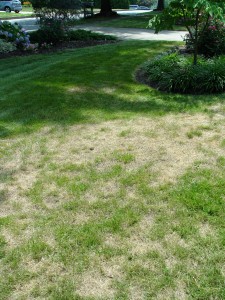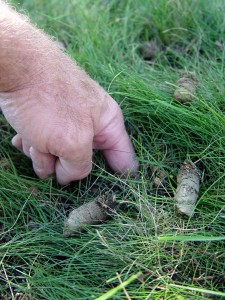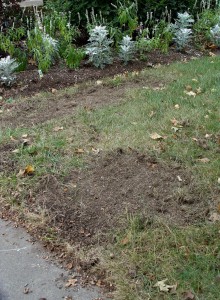Fixing a dead lawn
August 26th, 2010
Here we go again… more dead grass to replace.
This year, most of the brown patchiness is due to drought and intense heat. Some years the problem is more grubs and chinch bugs — although we’ve had plenty of lawn death from those, too.
Our cool-season grasses don’t tolerate super-hot weather very well – especially perennial ryegrass, which is one of the three main varieties used in most home lawns. It dies when temperatures start to top 100 degrees.
Grubs always do some damage, and chinch bugs also seem to be more active in hot, dry weather. The patches they kill are often mistaken for drought injury or grubs because chinch bugs are hard to detect. (Jam a coffee can cut off at both ends about an inch into the soil and flood it with water. If little bugs come floating to the top, odds are it’ll be chinch bugs you’ll find.)
Whatever the cause, the bottom line is that your grass is dead, and now through the end of October is the year’s best time window to replace it. If you don’t, weeds will move in and/or your soil may start to erode.
Where to start?
There are short cuts, but the most effective fix is to get down to bare dirt and loosen the soil surface.
Mow the lawn short and strip off or rake off dead matted grass. Then dig, till or scratch up the top 4 to 6 inches. This is a great time to improve the soil by digging an inch of compost, peat moss, mushroom soil or similar organic matter into the loosened existing soil.
For big areas, consider renting a dethatching machine (it tears apart dead matting and dead roots) and/or a core-aerator (a machine that opens holes by pulling up finger-sized cores of soil and depositing them on the surface).
“You’ve got to expose grass seed to the soil,” says Penn State Extension turfgrass specialist Jim Welshans.
You can’t just toss grass seed on dead grass and expect it to come up.
One other option if it’s just too labor-intensive for any of the above — slit-seeding. This involves renting a machine that makes shallow slits in the ground with blades that cut vertically as you go along. Behind each of the vertical blades is a hopper that drops seed into the slits.
Use good-quality seed
All grass is not created equal. Some varieties are much tougher, greener, thicker and more bug-, heat- and disease-resistant than others.
Penn State and dozens of other universities around the United States run turf trials every year, mainly to help golf courses and athletic-field managers find the best types. I’ve seen the difference variety makes at Penn State’s trial fields.
You can search out the top varieties yourself by accessing all of the university data at www.ntep.org.
At the very least, buy the best grade of the best brands you can find. You’ll pay slightly more, but it’s worth it.
Or go online to buy some of the best mixes available. I’ve ordered from www.seedland.com and was very satisfied with the service and quality.
Doing the deed
Scatter grass seed over the loosened surface at about the rate you’d salt a steak. Bags also give use-rate guidelines.
Lightly rake it in and tamp. Grass germinates best when pressed into the surface and mixed into the top one-quarter inch – no deeper.
Watering
This is your key to success. Grass seed needs consistent moisture until it’s up and growing.
This means at least a daily sprinkling – maybe more in hot, dry weather. Figure on 10 to 20 days for seed to germinate.
A very light layer of straw helps retain moisture and prevent runoff. Water enough to dampen the top inch or two but not so heavily that it runs off and washes away the seed.
Some people have good success using bags of lawn patch, which comes with seed, moisture-holding newspaper fiber and a mild dose of fertilizer.
Once it’s up
Cut back on the watering, but keep the hose handy if the top few inches of the soil go dry. Be vigilant right up until the ground freezes.
Try to stay off the young grass as much as possible.
In early November, put down an organic lawn fertilizer or a chemical one labeled for fall use or young grass.
Don’t worry about weeds for now. Consider using a crabgrass preventer or general organic weed preventer containing corn gluten meal early next spring.
Then pull weeds next spring or spot-spray with a liquid broadleaf weed-killer for lawns.










